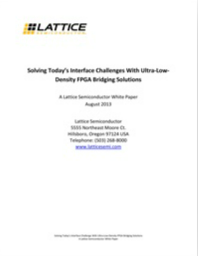Solving Today’s Interface Challenges With Ultra-LowDensity FPGA Bridging Solutions
Designers are implementing a wide variety of interface bridging solutions that allow them to transfer data across protocols and, in the process, expand system functionality. The challenge is determining how to most efficiently implement these new bridging solutions without violating system power, footprint and cost requirements.
This paper looks at potential solutions and examines how designers can tackle the interface challenge by implementing highly optimized bridging solutions in ultra-low density (ULD), low power field programmable gate arrays (FPGAs) that combine the flexibility of a programmable platform with high performance at low power.
Download to learn more.
Read More
By submitting this form you agree to Lattice Semiconductor Corporation contacting you with marketing-related emails or by telephone. You may unsubscribe at any time. Lattice Semiconductor Corporation web sites and communications are subject to their Privacy Notice.
By requesting this resource you agree to our terms of use. All data is protected by our Privacy Notice. If you have any further questions please email dataprotection@techpublishhub.com
Related Categories: Automotive, Communication, Embedded, Image sensors, Industrial, Microcontrollers, Power, Processors

More resources from Lattice Semiconductor Corporation
Solving Today’s Interface Challenges With Ultra-LowDensity FPGA Bridging Solutions
Designers are implementing a wide variety of interface bridging solutions that allow them to transfer data across protocols and, in the process, ex...
Implementing High-Speed DDR3 Memory Controllers in a Mid-Range FPGA
Implementing a highspeed, high-efficiency DDR3 memory controller in a FPGA is a formidable task. Until recently, only a few high-end (read: expensi...
RELIABLE RESET GENERATION FOR TI TMS320C6XXX (“DAVINCI”) PROCESSORS
Every microprocessor or DSP requires a reset generator circuit or IC to perform two functions: (1) start up from a fixed condition after the suppli...
